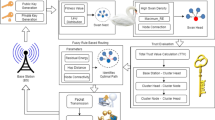Abstract
An energy-efficient routing is an essential task in a wireless sensor network topology. It provides a good cost metric encapsulating wireless link quality. Quality of service (QOS) based communication increases momentous challenges due to the growing real time applications need in wireless sensor networks (WSNs). In this paper, we propose a novel link quality based opportunistic routing method. Assessment of the link quality using link quality appraisal technique to identify and prevent the broadcast faults in the network. Opportunistic routing (OR) algorithm will select the relay nodes based on OR theory to enhance the lifetime of whole network and feasibly create the ideal transmission distance for energy saving. Finally, compare and estimate the performance of the proposed method in the working platform of Matlab simulation. Inspection of QoS is essential for improving the security measures availability, reliability and serviceability of the system within WSNs. Simulation results shows that our method achieves more energy savings, and higher packet delivery ratio.







Similar content being viewed by others
References
Mitra, S., & De Sarkar, A. (2014). Energy aware fault tolerant framework in wireless sensor network. IEEE Xplore. In Proceedings of 2014 applications and innovations in mobile computing (AIMoC) (pp. 139–145).
Chen W., & Luo, J. (2014). An improved LQI-based link quality estimation mechanism for wireless sensor networks. In Published in proceedings international conference on computer science and service system (CSSS) (pp. 74–79).
Lloyd, E. L., & Xue, G. (2007). Relay node placement in wireless sensor networks. IEEE Transactions on Computers, 56(1), 134–138.
Nitesh, K, & Jana, P. K. (2014). Relay node placement algorithm in wireless sensor network. IEEE, In Proceedings of IACC-2014 (pp. 220–225).
Gupta, S. K., Kuila, P., & Jana, P. K. (2013). GAR: An energy efficient GA-based routing for wireless sensor networks. In Proceedings of ICDCIT 2013, LNCS (Springer) (Vol. 7753, pp. 267–277).
LoBello, L., & Toscano, E. (2009). An adaptive approach to topology management in large and dense real-time wireless sensor networks. IEEE Transactions on Industrial Informatics, 5(3), 314–324.
Ren, F., Zhang, J., He, T., Lin, C., & Ren, S. K. (2011). EBRP: Energy balanced routing protocol for data gathering in wireless sensor networks. IEEE Transactions on Parallel and Distributed Systems, 22(12), 2108–2125.
Behnad, A., & Nader-Esfahani, S. (2011). On the statistics of MFR routing in one-dimensional ad hoc networks. IEEE Transactions on Vehicular Technology, 60(7), 3276–3289.
Ghasemi, A., & Nader-Esfahani, S. (2006). Exact probability of connectivity one-dimensional ad hoc wireless networks. IEEE Communications Letters, 10(4), 251–253.
Behnad, A., & Nader-Esfahani, S. (2010). Probability of node to base station connectivity in one-dimensional ad hoc networks. IEEE Communications Letters, 14(7), 650–652.
Piret, P. (1991). On the connectivity of radio networks. IEEE Transactions on Information Theory, 37(5), 1490–1492.
Santi, P., & Blough, D. M. (2003). The critical transmitting range for connectivity in sparse wireless ad hoc networks. IEEE Transactions on Mobile Computing, 2(1), 25–39.
Ramaiyan, V., Kumar, A., & Altman, E. (2012). Optimal hop distance and power control for a single cell, dense, ad hoc wireless network. IEEE Transactions on Mobile Computing, 11(11), 1601–1612.
Bhardwaj, M., Garnett, T., & Chandrakasan, A. P. (2001). Upper bounds on the lifetime of sensor networks. In Proceedings of IEEE international conference on communications (ICC’01) (Vol. 3, pp. 785–790).
Min, R., Bhardwaj, M., Ickes, N., Wang, A., & Chandrakasan, A. (2002). The hardware and the network: Total-system strategies for power aware wireless microsensors. In Proceedings of IEEE CAS workshop wireless communications network in Pasadena, CA, USA (pp. 36–12).
Cheng, L., Niu, J., Cao, J., Das, S., & Gu, Y. (2014). QoS aware geographic opportunistic routing in wireless sensor networks. IEEE Transactions on Parallel and Distributed Systems, 25(7), 1864–1875.
Perrig, A., Stankovic, J., & Wagner, D. (2004). Security in wireless sensor networks. Communications of the ACM, 47(6), 53–57.
Karlof, C., & Wagner, D. (2003). Secure routing in wireless sensor networks: Attacks and countermeasures. Ad hoc Networks, 1(2–3), 293–315.
Sun, X., Chen, H., Wu, X., Yin, X., & Song, W. (2016). Opportunistic communications based on distributed width-controllable braided multipath routing in wireless sensor networks. Ad Hoc Networks, 36, 349–367.
Silva, B., Fisher, R. M., Kumar, A., & Hancke, G. P. (2015). Experimental link quality characterization of wireless sensor networks for underground monitoring. IEEE Transactions on Industrial Informatics, 11, 1099–1110.
Ma, C., Liang, W., Zheng, M., & Sharif, H. A. (2016). Connectivity-aware approximation algorithm for relay node placement in wireless sensor networks. IEEE Sensors Journal, 16(2), 515–528.
Murugeswari, R., Radhakrishnan, S., & Devaraj, D. (2016). A multi-objective evolutionary algorithm based QoS routing in wireless mesh networks. Applied Soft Computing, 40, 517–525.
Gharghan, S. K., Nordin, R., Ismail, M., & Ali, J. A. (2016). Accurate wireless sensor localization technique based on hybrid PSO-ANN algorithm for indoor and outdoor track cycling. IEEE Sensors Journal, 16(2), 529–541.
Chiang, M. W., Zilic, Z., Radecka, K., & Chenard, J. S. (2004). Architectures of increased availability wireless sensor network nodes. In IEEE, test conference, proceedings, ITC 2004 (pp. 1232–1241).
Author information
Authors and Affiliations
Corresponding author
Rights and permissions
About this article
Cite this article
Bapu, B.R.T., Gowd, L.C.S. Link Quality Based Opportunistic Routing Algorithm for QOS: Aware Wireless Sensor Networks Security. Wireless Pers Commun 97, 1563–1578 (2017). https://doi.org/10.1007/s11277-017-4586-4
Published:
Issue Date:
DOI: https://doi.org/10.1007/s11277-017-4586-4




